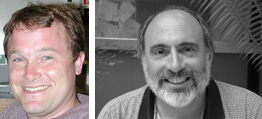UCMP welcomes two new Museum Scientists |
||
| David Haasl joins us from California
State University, Chico where he taught several courses in Geology including
stratigraphy, invertebrate paleontology, and environmental geology. However,
David is not new to UCMP. During the summer of 2000, David worked as an
assistant museum scientist at UCMP, coordinating the organization and
integration of an extensive collection of invertebrate material from the
USGS at Menlo Park. David received his Ph.D. in Geology from UC Davis,
working with Sandra Carlson. He will maintain the invertebrate collections,
which include mollusks, brachiopods, corals, and insects. |
 New Museum Scientists David Haasl (left) and Ken Finger. (photos by Colleen Whitney) California. Ken will maintain the microfossil collections of UCMP.
Return to Front page |
|